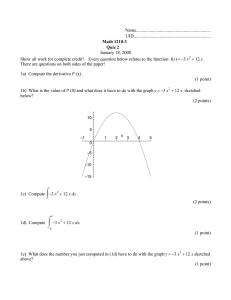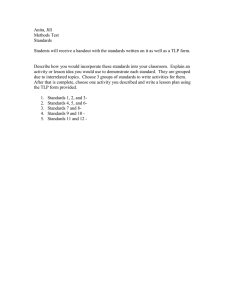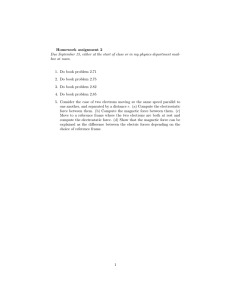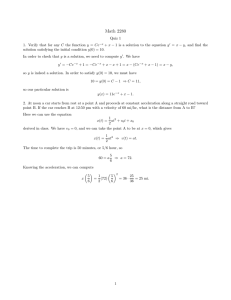Extra exercise 30-a: A slidewire generator
advertisement
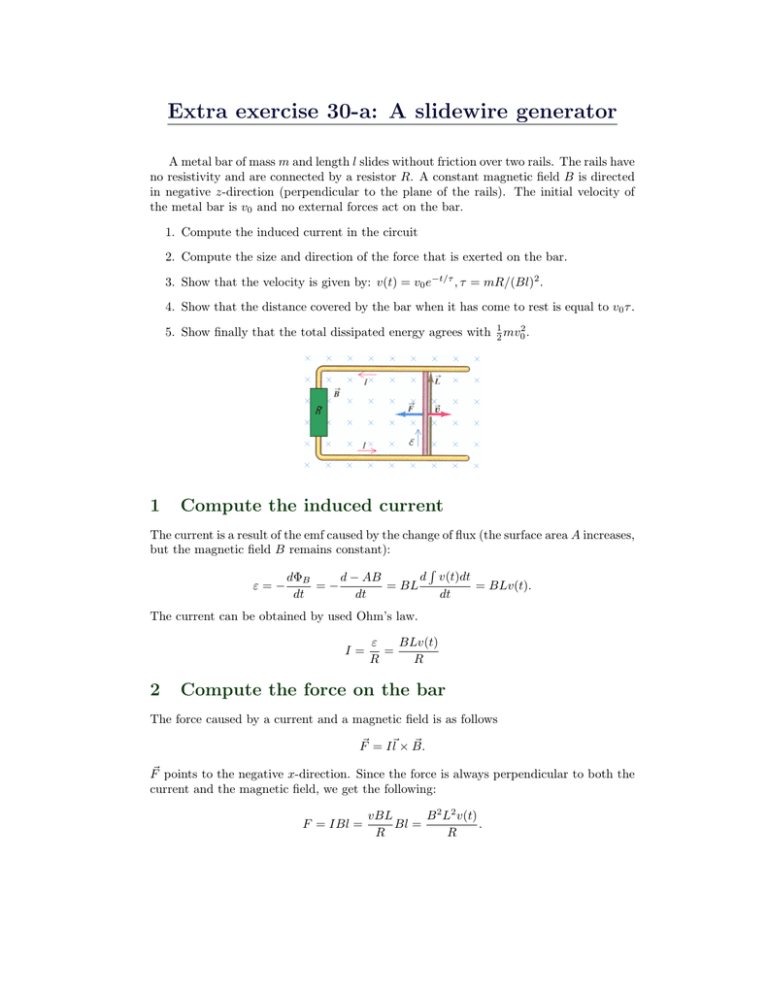
Extra exercise 30-a: A slidewire generator A metal bar of mass m and length l slides without friction over two rails. The rails have no resistivity and are connected by a resistor R. A constant magnetic field B is directed in negative z-direction (perpendicular to the plane of the rails). The initial velocity of the metal bar is v0 and no external forces act on the bar. 1. Compute the induced current in the circuit 2. Compute the size and direction of the force that is exerted on the bar. 3. Show that the velocity is given by: v(t) = v0 e−t/τ , τ = mR/(Bl)2 . 4. Show that the distance covered by the bar when it has come to rest is equal to v0 τ . 5. Show finally that the total dissipated energy agrees with 12 mv02 . 1 Compute the induced current The current is a result of the emf caused by the change of flux (the surface area A increases, but the magnetic field B remains constant): R d v(t)dt dΦB d − AB ε=− =− = BL = BLv(t). dt dt dt The current can be obtained by used Ohm’s law. I= 2 ε BLv(t) = R R Compute the force on the bar The force caused by a current and a magnetic field is as follows ~ F~ = I~l × B. F~ points to the negative x-direction. Since the force is always perpendicular to both the current and the magnetic field, we get the following: F = IBl = B 2 L2 v(t) vBL Bl = . R R 3 Compute the velocity of the bar The velocity is equal to the initial velocity minus the deceleration caused by the preceding force: Z t Z Z F (t) 1 t B 2 L2 v(t) B 2 L2 t v(t) = v0 − dt = v0 − dt = v0 − v(t)dt. m m 0 R mR 0 0 This differential equation can be solved by using an expression in the form of v(t) = c1 ec2 t . When we use c2 = − τ1 , τ = BmR 2 L2 , we get a correct expression. t v(t) = c1 e− τ = v0 − B 2 L2 mR Z t 1 c1 e− τ dt = v0 − 0 − τt t t B 2 L2 mR −c1 2 2 e− τ mR B L 0 1 t = v0 + c1 e− τ − c1 = v0 e− τ v(t) = c1 e And this agrees with the given expression. 4 Compute the distance covered by the bar The distance is the integral of the speed over the time. When the bar has come to rest, it’s velocity is zero and that happens at t = ∞, so we integrate from zero to infinity: Z ∞ Z ∞ h i t t ∞ x= v(t)dt = v0 e− τ dt = −v0 τ e− τ = v0 τ. 0 5 0 0 Compute the total dissipated energy The power is equal to the product of emf and current: P (t) = ε(t)I(t) = v(t)2 B 2 L2 v 2 B 2 L2 −2 t ε(t)2 = = 0 e τ. R R R The energy is the integral of the power over the time. We want to compute the energy from the beginning until the bar is at rest, so t ∈ 0, ∞ . ∞ ∞ Z v02 B 2 L2 −2 t Bpdf te2 L2 v02 ∞ −2 t τ E = P (t)dt = dt = e e τ dt R R 0 0 0 ∞ B 2 L2 v02 B 2 L2 v02 1 1 −2 t 1 B 2 L2 mR τ = = − τe τ = v02 R 2 R 2 2 R B 2 L2 0 1 = mv02 . 2 Z Z And this is indeed equal to the initial kinetic energy of the bar. This document was created by Willem van Engen (wvengen@stack.nl) Homepage: http://willem.n3.net
